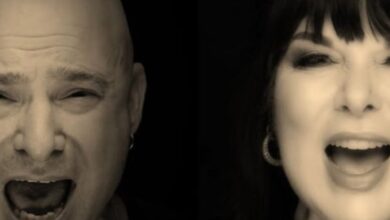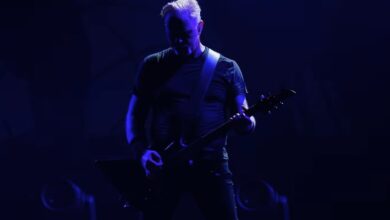Disturbed’s Mesmerizing Conan Performance Turns “The Sound of Silence” Into a Haunting, Generation-Defining Masterpiece
When March 2016 arrived, few could have imagined that one of metal’s loudest and most aggressive bands would choose stillness over fury. On March 28, Disturbed took the stage on Late Night with Conan O’Brien and unveiled a side of themselves the world had never seen. Their performance of Simon & Garfunkel’s “The Sound of Silence” left the studio frozen in awe. It wasn’t just a cover—it was an awakening, where raw vulnerability collided with unyielding strength, forever altering how listeners perceived the band’s emotional reach.
Those who filled the audience that night expected thunderous guitars and booming drums, but instead found themselves enveloped in calm. The studio lights dimmed to a gentle glow, and the hum of anticipation filled the air. When David Draiman’s baritone emerged, low and reverent, it silenced the room completely. Each phrase carried weight, floating through the air like a confession whispered in the dark. The quiet was so deep it felt almost tangible, as if every breath shared by the audience was part of the performance itself.
What followed blurred generational lines. The original creator, Paul Simon, happened to watch the televised performance and was deeply moved by its intensity. Days later, on April 1, 2016, he personally emailed Draiman, describing the rendition as “deeply powerful and emotionally charged.” That gesture united two musical eras—one voice that had once spoken for a generation and another that reimagined it for a new one. It was a silent exchange of respect between two storytellers whose art transcended time.
In his response, Draiman expressed profound gratitude, calling Simon’s praise one of the greatest honors of his life. He emphasized that Disturbed’s purpose had never been to surpass the original, but to pay tribute to its haunting message of isolation and yearning. That shared humility transformed the moment into something larger than genre. It became an artistic bridge—a dialogue between rock’s force and folk’s fragility, joined by the same heartbeat of emotion that first gave the song life half a century earlier.
The band had first introduced the cover on their sixth album, Immortalized, released in August 2015. Nestled among aggressive anthems and roaring guitars, it stood out as a quiet anomaly—unexpected yet magnetic. Audiences were instantly drawn to its solemnity, and the song quickly climbed the charts, reaching number 42 on the Billboard Hot 100 while topping both the Hard Rock Digital and Mainstream Rock lists. What had begun as a soft interlude within a heavy record soon became Disturbed’s most celebrated masterpiece.
When released as a single in December 2015, the track showcased an entirely different sonic identity. Guitarist Dan Donegan’s interplay of acoustic and electric textures wrapped around Draiman’s voice like a cathedral of sound. Mike Wengren’s drums pulsed with restraint, guided by orchestral percussion rather than brute strength. The mix shimmered with cinematic depth, balancing delicacy with immense power. The result was not a song built for volume, but for atmosphere—an emotional architecture where every note was placed with intention and reverence.
Bringing that arrangement to Conan’s stage turned reverence into revelation. The familiar buzz of television chatter vanished the moment the music began. Draiman’s delivery oscillated between tenderness and command, ascending into crescendos that rippled through the air like controlled thunder. Viewers watching at home described chills that refused to fade, as if something sacred had unfolded through their screens. A late-night performance had become a modern hymn, and for a few unforgettable minutes, silence itself became the loudest sound in the room.
Reactions poured in from all sides. Some critics questioned its theatricality, while others hailed it as genius. Yet beneath every differing opinion ran a shared awe for its sincerity. Disturbed had shed their armor of aggression to reveal something startlingly human. The performance wasn’t about spectacle—it was about truth. In a culture saturated with irony, their vulnerability felt radical. It reminded audiences that even the heaviest bands could wield tenderness as their most powerful instrument.
The performance spread across the internet like a storm carried on a whisper. By 2017, “The Sound of Silence” had sold over 1.5 million digital copies and collected hundreds of millions of streams. The official music video surpassed one billion views, while the Conan rendition became the most-watched clip in the show’s history, crossing 150 million. What began as an experiment in restraint had transformed into a global phenomenon, uniting listeners across generations under the universal language of emotion.
Its strength lay in its contrasts—fury turned inward, rebellion softened into grace, noise replaced by stillness. It was an unlikely blend of eras: the introspection of the 1960s intertwined with the modern ache of the 2010s. Disturbed didn’t reinterpret the song as rebellion but as reverence. Each note was treated like scripture, each pause like prayer. Their performance was a meditation on the beauty of restraint, a reminder that silence can hold as much power as any scream.
For the band, that night marked a resurrection. After four years of silence, Immortalized had already proven their comeback, debuting at number one on the Billboard 200. Yet “The Sound of Silence” went further—it was reinvention. It revealed a side of Disturbed capable of contemplation and emotional depth, showing that strength doesn’t always roar; sometimes it whispers. In those quiet moments, the band found a new definition of power—one rooted not in dominance but in connection.
Much of that transformation was guided by producer Kevin Churko, who helped shape their sound toward a balance of intimacy and magnitude. He replaced distortion with strings, aggression with space, and chaos with clarity. The orchestral arrangement bridged genres, connecting the raw pulse of metal with the emotional resonance of classical music. It was a masterclass in restraint—a demonstration that evolution doesn’t mean abandoning roots, but letting them grow deeper in unexpected directions.
Recognition soon followed. The song earned a Grammy nomination for Best Rock Performance in 2017, solidifying its place as one of the era’s defining reinterpretations. For Disturbed, the honor was more than validation—it was a symbol of courage. It confirmed that stepping outside familiar boundaries can lead to true artistic freedom. Their reimagining of “The Sound of Silence” wasn’t merely a success; it was a testament to the timeless value of sincerity in a world desperate for authenticity.
Those fortunate enough to witness the performance live still recall the atmosphere as almost sacred. They had expected a barrage of sound, yet found themselves disarmed by stillness. Hearts raced where ears had anticipated noise. The applause that followed wasn’t wild; it was reverent, the kind reserved for something profound. In that fleeting moment, it became clear that the loudest thing Disturbed had ever created wasn’t a riff or a roar—it was a feeling.
That night changed not only Disturbed’s trajectory but the broader understanding of what modern rock could be. The performance transcended fandom and genre, uniting strangers in a shared silence that spoke louder than any lyric. Couples wept, friends clasped hands, and countless viewers around the world found comfort in the sound that once symbolized isolation. A song born from the unrest of the 1960s had found rebirth in the 21st century, echoing humanity’s eternal need for connection.
Years later, Disturbed’s “The Sound of Silence” remains a cultural touchstone—a performance that transformed reverence into revelation. It stands not as a cover but as a reinvention, bridging eras and emotions. Draiman’s voice didn’t simply reinterpret Simon’s words; it resurrected them, reminding listeners that music’s greatest power lies in its capacity to move, to heal, and to unify. In their hands, silence became more than absence—it became an anthem of presence, echoing endlessly through the hearts it touched.





